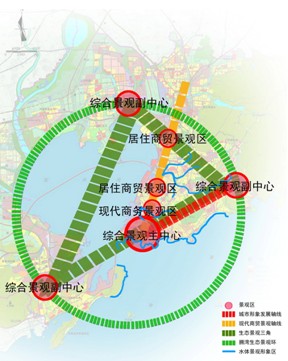1 Introduction Figure 1  Urban landscape lighting area map    Among them, “one main, three sub-three districts†is the main integrated landscape center consisting of the south of the city, three comprehensive landscape sub-centers composed of Lushan, Huangdao and Hongdao, and three consisting of Shibei, Sifang and Li Wei. Landscape area.
Thanks to the 2008 Olympic Sailing Competition held in Qingdao, Qingdao launched a large-scale urban landscape lighting construction, which has undergone tremendous changes in the face of the city, but with the progress of Qingdao to the international metropolis. In the middle, it is also clear that there are still many problems in the quality improvement stage of “not high, no wide, no special†in Qingdao. Qingdao is a national historical and cultural city and a famous scenic tourist destination. The natural resources and human resources are rich in types and numerous in number. It has the unique landscape resources of most cities at home and abroad. For such a carrier, it has a unique and already considerable landscape. In the city of lighting construction, how to do landscape lighting planning in the stage of quality improvement of landscape lighting has become a very important and new topic.
Entrusted by Qingdao Lianghua Command in December 2009, the Urban Lighting Planning and Design Institute of Beijing University of Technology and Beijing Saigao Urban Environment Lighting Planning and Design Company undertook the task of preparing the overall planning of Qingdao landscape lighting, and in March 2010 Accredited.
   2 Planning principles and objectives
2.1 Planning Principles (1) Distinctively remodeling and reappearing the humanities and natural landscapes of Qingdao at night, focusing on the city's natural landscape features and the characteristics of the bay landscape, grasping the characteristics of the “Binhai City†and shaping the night scene with the unique style of Qingdao.
(2) Clearly constructing a modern and glamorous night city, responding to Qingdao's urban development orientation and the spatial development strategy of “Banwan Developmentâ€, and building a spatial pattern of “Greater Qingdaoâ€.
(3) Connotation rich In the deep excavation of Qingdao regional culture, realize the organic integration of technology, art and culture, to show the historical and cultural city style, and to construct the urban landscape lighting with distinctive cultural connotation and artistic value. effect.
(4) energy saving and environmental protection in accordance with the relevant national standards and the Ministry of Housing, put forward reasonable energy savings objectives, priorities and targets, and the implementation of measures.
2.2 Planning Objectives To build the urban spatial pattern of “Greater Qingdao†and build a modern international charm night city. Based on the functional lighting, this plan shows the characteristics of the coastal, riverside and natural mountain through landscape lighting, and combines the human landscape to reflect the urban characteristics of Qingdao's “mountain, sea, city, river and islandâ€. Taking the landscape lighting of the main city of Qingdao as the engine, the axial radiation of the Shandong Peninsula will drive the overall development of the landscape lighting in Qingdao, and strive to create the landscape lighting of the three sub-centers of Hongdao, Huangdao and Lushan and the coastline of Jiaozhou Bay in Qingdao. The districts are unified with the landscape lighting of the main urban area of ​​Qingdao, creating an integrated spatial layout, which enables the “Greater Qingdao†to form and ultimately realize the urban spatial development strategy of “Greater Qingdaoâ€.
   3 Planning achievements and urban imagery
3.1 The city's lighting positioning is divided into the construction of “Greater Qingdao†urban spatial layout. According to the analysis of Qingdao's land use status, urban master plan, functional orientation of each district, and urban development strategy, “one main three sub-districts and two axes are determined. The city's lighting pattern of the triangle one ring connects the various landscape areas of the city with the linear landscape belt, forming a three-zone, relying on the main city, the belt-shaped centripetal, the radiation distribution, and one main and three deputy, each with its own characteristics. The urban landscape lighting spatial pattern will organically combine the spatial layout of the cities in the central city of Qingdao, and let the development strategy of “Greater Qingdao†fall into the construction (see Figure 1). 
The "two axes" is the axis of urban image development and the axis of modern business landscape. Organizing the spatial sequence with the axis creates a strong restraining force on the space. Through these two axes, the sense of order of the night scene is strengthened, reflecting the characteristics of the city and forming a series of night landscapes with different styles, differences and organic unity.
In addition, the "triangle" and "one ring" are important means to build "Greater Qingdao." “Triangle†or “ecological landscape triangle†refers to the triangular structure formed by the three integrated landscape sub-centers of Hongdao, Huangdao and Lushan, which run through the main center of the integrated landscape. "One Ring" or "Ecological Landscape Ring" refers to relying on "one master" as the core, "three pairs" as the focus point, and radiation to drive the ring-shaped overall structure of other areas.
Through such urban lighting positioning, it can effectively guide the integration of the two wings of Jiaozhou Bay, forming a city circle based on Jiaozhou Bay and supporting Qingdao, Huangdao and Hongdao to create a ring of Jiaozhou Bay, thus making the “Greater Qingdao†night shape. God has both.